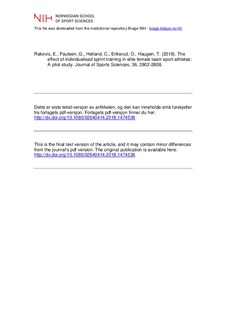| dc.contributor.author | Rakovic, Elvir | |
| dc.contributor.author | Paulsen, Gøran | |
| dc.contributor.author | Helland, Christian | |
| dc.contributor.author | Eriksrud, Ola | |
| dc.contributor.author | Haugen, Thomas | |
| dc.date.accessioned | 2019-05-15T14:35:29Z | |
| dc.date.available | 2019-05-15T14:35:29Z | |
| dc.date.created | 2018-10-09T15:51:09Z | |
| dc.date.issued | 2018 | |
| dc.identifier.citation | Journal of Sports Sciences. 2018, 36, 2802-2808. | nb_NO |
| dc.identifier.issn | 0264-0414 | |
| dc.identifier.uri | http://hdl.handle.net/11250/2597731 | |
| dc.description | I Brage finner du siste tekst-versjon av artikkelen, og den kan inneholde ubetydelige forskjeller fra forlagets pdf-versjon. Forlagets pdf-versjon finner du på tandfonline.com / In Brage you'll find the final text version of the article, and it may contain insignificant differences from the journal's pdf version. The definitive version is available at tandfonline.com | nb_NO |
| dc.description.abstract | This study aimed to evaluate whether an individualised sprint-training program was more effective in improving sprint performance in elite team-sport players compared to a generalised sprint-training program. Seventeen elite female handball players (23 ± 3 y, 177 ± 7 cm, 73 ± 6 kg) performed two weekly sprint training sessions over eight weeks in addition to their regular handball practice. An individualised training group (ITG, n = 9) performed a targeted sprint-training program based on their horizontal force-velocity profile from the pre-training test. Within ITG, players displaying the lowest, highest and mid-level force-velocity slope values relative to body mass were assigned to a resisted, an assisted or a mixed sprint-training program (resisted sprinting in the first half and assisted sprinting in the second half of the intervention period), respectively. A control group (CG, n = 8) performed a generalised sprint-training program. Both groups improved 30-m sprint performance by ~1% (small effect) and maximal velocity sprinting by ~2% (moderate effect). Trivial or small effect magnitudes were observed for mechanical outputs related to horizontal force- or power production. All between-group differences were trivial. In conclusion, individualised sprint-training was no more effective in improving sprint performance than a generalised sprint-training program. | nb_NO |
| dc.language.iso | eng | nb_NO |
| dc.subject | physical training | nb_NO |
| dc.subject | physical performance | nb_NO |
| dc.subject | acceleration | nb_NO |
| dc.subject | horizontal power production | nb_NO |
| dc.subject | handball | nb_NO |
| dc.title | The effect of individualised sprint training in elite female team sport athletes: A pilot study | nb_NO |
| dc.type | Journal article | nb_NO |
| dc.type | Peer reviewed | nb_NO |
| dc.description.version | acceptedVersion | nb_NO |
| dc.source.pagenumber | 2802-2808 | nb_NO |
| dc.source.volume | 36 | nb_NO |
| dc.source.journal | Journal of Sports Sciences | nb_NO |
| dc.source.issue | 24 | nb_NO |
| dc.identifier.doi | 10.1080/02640414.2018.1474536 | |
| dc.identifier.cristin | 1619121 | |
| dc.description.localcode | Seksjon for fysisk prestasjonsevne / Department of Physical Performance | nb_NO |
| cristin.unitcode | 150,31,0,0 | |
| cristin.unitname | Seksjon for fysisk prestasjonsevne | |
| cristin.ispublished | true | |
| cristin.fulltext | postprint | |
| cristin.qualitycode | 1 | |
